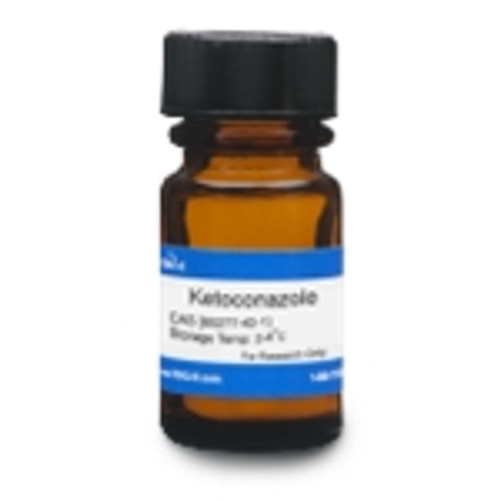Ketoconazole is an azole antimycotic compound that was discovered in 1976 (Janssen Pharmaceuticals) and patented in 1977. It is a racemic mixture of the two enantiomers: levoketoconazole and dextroketoconazole. It is a bioactive small molecule acting as a protein inhibitor, specifically inhibiting CYP3A5 involved in P-450-dependent steroid biosynthesis. The compound has anti-cancer activity.
Ketoconazole is soluble in DMSO, ethanol, chloroform, and methanol.
This product is considered a dangerous good. Quantities above 1 gram may be subject to additional shipping fees.
| Mechanism of Action | Ketoconazole increases cell permeability by inhibiting enzymes involved in ergosterol synthesis, specifically the enzyme P450 14 alpha-demethylase (CYP51A1) which converts lanosterol to ergosterol. The increased permeability has a toxic effect on the fungi and leads to cell death. |
| Microbiology Applications | Resistance to Ketoconazole has been observed in a number of clinical fungal isolates, including Candida albicans. Resistance arises as a result of mutations in the sterol biosynthesis pathway. Multidrug-resistance (MDR) genes can also play a role in reducing the cellular levels of the compound. |
| Cancer Research Applications | Ketoconazole was tested on hepatocellular carcinoma cells, cell-line-derived xenografts, and a xenograft (PDX) model. It induced mitophagy both in vitro and in vivo via downregulation of cyclooxygenase-2 to induce apoptosis. This supports a novel link between Ketoconazole and mitophagy machinery for cancer research applications (Chen et al, 2019). |
| Spectrum | Ketoconazole is a broad-spectrum antifungal agent targeting a wide variety of fungal cell membranes. |
| Molecular Formula | C26H28Cl2N4O4 |
| References |
Chen Y et al (2019) Ketoconazole exacerbates mitophagy to induce apoptosis by downregulating cyclooxygenase-2 in hepatocellular carcinoma. J. Hepatol. 70(1):66-77 PMID 30287340 Heeres J, Backx LJ, Mostmans JH, Van Cutsem J (1979) Antimycotic imidazoles. Part 4. Synthesis and antifungal activity of Ketoconazole, a new potent orally active broad-spectrum antifungal agent. J. Med. Chem. 22(8):1003-1005 PMID 490531 Morsy MA, Sultan SM, Dafalla H (2009) Electron paramagnetic resonance method for the quantitative assay of Ketoconazole in pharmaceutical preparations. Anal. Chem. 81(16):6991-6995 PMID 20337383 Nardone PA, Slotman GJ, Vezeridis MP (1988) Ketoconazole: a thromboxane synthetase and 5-lipoxygenase inhibitor with antimetastatic activity in B16-F10 melanoma. J. Surg. Res. 44(4):425-429 PMID 3361885 Rice LB and Ghannoum MA (1999) Antifungal Agents: Mode of action, mechanisms of resistance, and correlation of these mechanisms with bacterial resistance. Clin. Microbiol. Rev. 12(4):501-517 PMID 10515900 Van Tyle JH (1984) Ketoconazole. Mechanism of action, spectrum of activity, pharmacokinetics, drug interactions, adverse reactions and therapeutic Use. Pharmacother. 4(6):343-373 PMID 6151171 |



